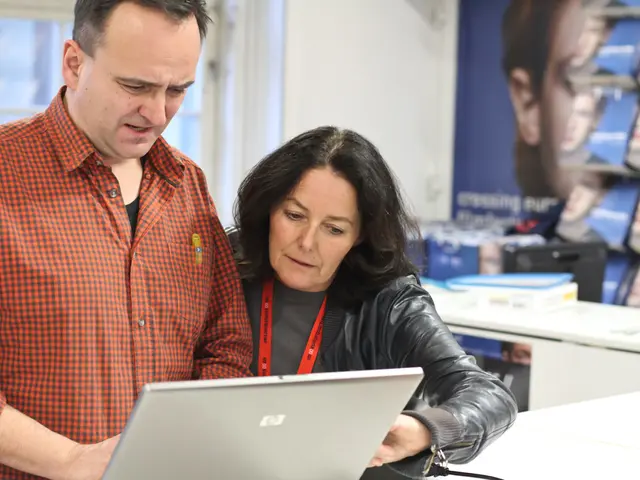Space Artificial Intelligence: Paving the Way for a New Age of Cosmic Discovery
The Kepler Space Telescope, though its mission ended in 2018, continues to make waves in the realm of space exploration. It has recorded the brightnesses of over 150,000 stars, contributing significantly to our understanding of the cosmos [1].
In the lab, Dr. Mario Krenn and his team at the 'Artificial Scientist Lab' are pushing boundaries. They have developed an AI named Urania, designed to find better designs for gravitational wave detectors. Surpassing the best-known next-generation designs, Urania is a testament to the potential of AI in space exploration [2].
However, the energy requirements to keep AI systems running are a significant challenge for deep space missions. As the field of AI in space exploration grows, finding efficient solutions to this issue becomes increasingly important [3].
AI is not just a buzzword in space exploration; it's a reality. Current applications include autonomous decision-making for spacecraft, enhanced onboard data processing, and AI-assisted medical support for astronauts. For instance, NASA's Dynamic Targeting technology allows Earth-observing satellites to autonomously analyse imagery, identify phenomena, and reorient themselves to capture more valuable data [1].
The International Space Station (ISS) is also leveraging AI through an orbital data center project, aiming to expand real-time data storage and processing capabilities, crucial for future commercial stations and deep-space missions [3].
Looking ahead, the possibilities for AI in space exploration are vast. Autonomous spacecraft operations, medical AI assistance, and AI in spacecraft design and mission planning are just a few examples of potential future applications [2]. NASA and Google are even developing an AI-powered Crew Medical Officer Digital Assistant to help astronauts diagnose and treat health issues autonomously during long-duration missions [4][5].
Future AI systems could also understand emotions, interact naturally, and provide psychological support to astronauts during long missions, according to experts at ESA [6].
In 2023, AI was used to process vast carbon monoxide datasets from the Nobeyama 45-meter radio telescope, identifying 140,000 molecular clouds in the Milky Way with 76% accuracy [7]. The Vera C. Rubin Observatory was also inaugurated, expected to take 1,000 images of the southern hemisphere sky every year [8].
With Artificial General Intelligence (AGI), AI systems could have autonomous decision-making capabilities in space missions, further revolutionising space exploration [2]. The accuracy and quality of training data are crucial challenges in the wide use of AI for space exploration [9].
As NASA's science data holdings exceed 100 petabytes [10], the need for efficient and intelligent data processing systems becomes more apparent. The launch of the SPHEREx space telescope in March 2025 is a step in this direction [11].
In summary, AI is enhancing autonomous data collection and processing in orbit, and its future use prospects span intelligent spacecraft autonomy, enhanced onboard health care, and advanced mission design and analysis systems critical for deep space exploration and extended human missions beyond Earth orbit [1][2][3][4][5]. The future of space exploration is undeniably intertwined with the development and implementation of AI technology.
References: [1] NASA (2021). Dynamic Targeting. Retrieved from https://www.nasa.gov/offices/oce/about/dynamic_targeting.html [2] International Space University (2021). AI Applications to Space Workshop. Retrieved from https://www.isunet.edu/events/ai-applications-space-workshop [3] NASA (2021). Orbital Data Center. Retrieved from https://www.nasa.gov/mission_pages/station/research/news/orbital-data-center.html [4] NASA (2021). Crew Medical Officer Digital Assistant. Retrieved from https://www.nasa.gov/mission_pages/station/research/news/crew-medical-officer-digital-assistant.html [5] Google (2021). Google and NASA team up to develop AI for long-duration space missions. Retrieved from https://blog.google/technology/ai/google-nasa-team-up-develop-ai-long-duration-space-missions/ [6] ESA (2021). AI in Space. Retrieved from https://www.esa.int/Applications/Space_for_Everyone/AI_in_Space [7] Nobeyama Radio Observatory (2021). AI for Radio Astronomy. Retrieved from https://www.nro.nao.ac.jp/en/research/ai_for_radio_astronomy/ [8] Vera C. Rubin Observatory (2021). First Light. Retrieved from https://www.lsst.org/news/first-light [9] NASA (2021). AI for Space Exploration. Retrieved from https://www.nasa.gov/feature/ai-for-space-exploration [10] NASA (2021). Science Data Holdings. Retrieved from https://www.nasa.gov/mission_pages/science/data-holdings.html [11] NASA (2021). SPHEREx. Retrieved from https://www.nasa.gov/mission_pages/spherex/index.html
Artificial Intelligence (AI) and science intertwine as Dr. Mario Krenn's team develop the AI named Urania, designed to design gravitational wave detectors, surpassing even the best-known next-generation designs [2]. AI's potential in space-and-astronomy expands beyond known boundaries, with possible applications in autonomous spacecraft operations, medical AI assistance, and AI in spacecraft design and mission planning [2].
Furthermore, AI plays a crucial role in advanced data processing systems, such as the SPHEREx space telescope, which aims to process science data more efficiently [11]. These advancements hold the promise of revolutionizing future space explorations, as the development and implementation of AI technology converge with the future of space exploration.




